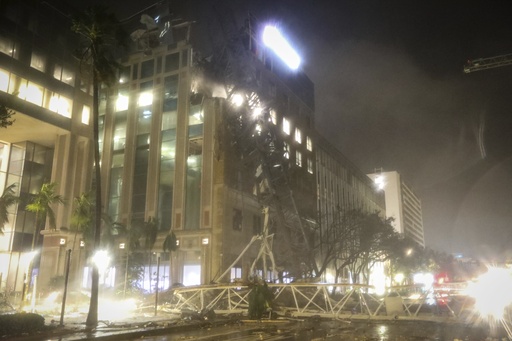In St. Petersburg, Florida, residents were cautioned by the mayor regarding the potential dangers posed by cranes involved in multiple construction projects in the city due to Hurricane Milton. At the height of the storm on Wednesday night, one of these cranes collapsed dramatically.
Fortunately, there were no injuries reported when a crane, which was part of a 46-story residential and office building that is set to become the tallest tower on the Gulf Coast of Florida, fell onto a nearby building that houses the Tampa Bay Times. The accident resulted in a gaping hole in the brick and concrete structure where part of the crane came to rest. Debris, including twisted metal and office items, was scattered around the area, and a section of the crane obstructed the street below. Winds from Hurricane Milton also caused damage at Tropicana Field, home of the Tampa Bay Rays, ripping off panels from its roof.
At the time of the crane’s collapse, the newspaper office was unoccupied, which avoided any injuries. In response to the incident, city officials cordoned off several blocks to evaluate the damage and start the process of clearing the fallen crane. The developer, Red Apple Group, noted that part of the crane’s upper section had collapsed, and they were collaborating with city officials to assess the situation further. However, they did not reply to requests for further comment.
The 400 Central skyscraper, which is currently under construction, is designed to reach a height of 515 feet (157 meters) and will include 301 condominiums starting at prices of $1 million, along with retail and office space, as reported by local media. Dismantling the damaged crane will likely require the use of another crane, as it is typical for construction teams to need additional cranes for such heavy lifting tasks.
Most cranes used for erecting tall buildings are classified as tower cranes and can extend their own height as the structure rises. Ensuring safety while operating cranes involves carefully managing the various weights and forces at play.
According to crane safety expert Tom Barth, who has nearly four decades of experience in the field, the crane operator must react wisely in windy conditions. Upon shutting down the crane, the operator engages ‘weather vane’ mode, allowing the crane to rotate with the wind. This movement minimizes resistance that would occur if the crane stayed fixed like a hand obstructing a stream of water.
Barth noted that cranes are usually constructed to withstand winds of at least 100 mph (161 kph), and those positioned in hurricane-prone areas like Florida are often designed with enhanced wind resistance. However, there are limits to the amount of wind force any crane can withstand. This prompted Mayor Kenneth Welch to advise nearby residents to evacuate and led police to ensure that vulnerable areas were cleared.
Removing cranes can be a painstaking process that takes days or even longer, as they need to be carefully raised and then dismantled. This timeline is crucial, especially when meteorologists begin to finalize storm predictions and paths, leaving little time for safe operations.


